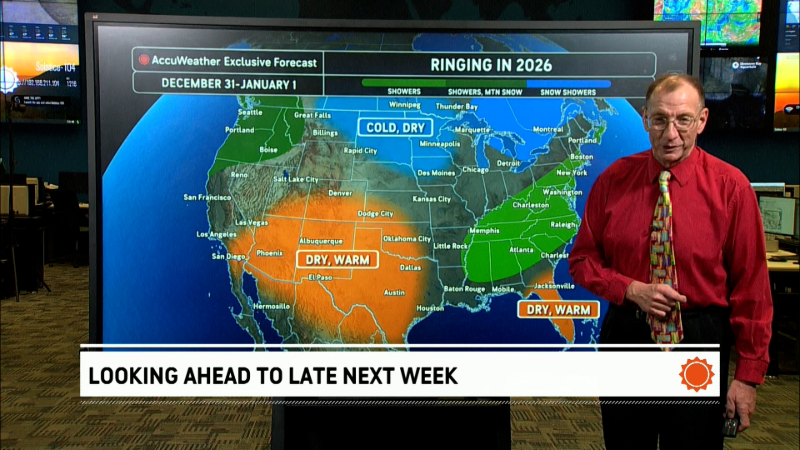Solar eclipse Q&A: Answering the 10 biggest questions
April's total solar eclipse is almost here, and AccuWeather has the answer to some of the biggest questions leading up to the astronomy event of the decade.
It’s been reported during past solar eclipses that some animals change their behavior thinking night has fallen. Here’s how an eclipse can affect wildlife.
Social media has been flooded with questions about April's total solar eclipse, ranging from where to see it, what to expect and how to secure a pair of eclipse glasses. AccuWeather gathered the 10 biggest questions and has detailed answers to help people leading up to the astronomy event of the decade.
Where do you need to be to see the total solar eclipse?

A map showing the path of totality where a total solar eclipse will be visible on April 8, 2024. (NASA's Scientific Visualization Studio)
To witness the total solar eclipse, you will need to be in a narrow zone called the path of totality, which will extend from Mexico, across part of the central and eastern United States and over Atlantic Canada. Areas of North America outside of this area will experience only a partial solar eclipse.
Why will schools and businesses be closed on eclipse day?
Millions of people are expected to pack into the path of totality on April 8, which will create widespread travel congestion. In parts of the eastern U.S., the total eclipse will occur around the same time that schools dismiss, adding school busses filled with children to the travel chaos and gridlocks that may ensue in the path of totality as crowds of spectators begin the journey home.
What will the weather be like for the eclipse? Will clouds ruin the event?
This is the million-dollar question. The cloud forecast is complex as meteorologists need to predict the cloud forecast for the four-minute window when the moon completely blocks out the sun. AccuWeather's first cloud outlook was issued on Thursday, March 7, and called for the best chance of good weather to be in Texas and part of the Ohio Valley. The forecast will be updated as the eclipse approaches, so be sure to check the AccuWeather forecast frequently for the latest predictions.
If it’s raining, can we still see the eclipse?
Yes, although it will not be as impressive. Even if it is overcast and raining during the total solar eclipse, it will still become dark outside as if it were nighttime for several minutes before gradually becoming bright again.
How rare are solar eclipses?

A time-sequence composite of the August 21, 2017 total solar eclipse. (Getty Images)
Solar eclipses are not rare, as they occur every year somewhere in the world, but it is rare to have a total solar eclipse happen in a specific part of the world. Before the 2017 eclipse, the most recent total solar eclipse visible from the contiguous United States occurred in 1979.
Is it too late to buy eclipse glasses?
No, but time is running out. The American Astronomical Society has a list of retailers that sell certified eclipse glasses that meet international safety standards. Libraries and stores near the path of totality may also have eclipse glasses available.
What happens if you look at the sun without eclipse glasses?
You need eclipse glasses to watch the solar eclipse safely. Even a few short moments of looking at the sun without eye protection can cause permanent damage.
Looking at the sun without the proper eclipse glasses or solar filter can lead to serious, sometimes permanent, eye damage. The intense sunlight can lead to burns on the retina and, in extreme scenarios, blindness. The retina does not have pain receptors, so people who look at the sun will not know their eyes are damaged until it is too late.
Do eclipse glasses from 2017 still work?

Tyler Hanson watches the sun moments before the total eclipse in Nashville, Tenn.
Yes, as long as the solar filters in the glasses are not scratched or damaged. Eclipse glasses and solar filters that meet the international safety standard can be used indefinitely, according to the American Astronomical Society. Make sure the glasses have this code printed on them: ISO 12312-2.
Is it worth driving long distances to the path of totality?
This answer is different from person to person depending on work schedules, ability to travel and personal finances. Traveling across the country can be expensive, but seeing a total solar eclipse will be a lifelong memory.
For example, if you live in California, you are interested in seeing the eclipse and have the means to travel for the eclipse, it might be worth the time and money. The next time a total solar eclipse will be visible in California won't be for another 21 years.
When is the next total solar eclipse in the United States?
The next total solar eclipse visible from the United States will be on March 30, 2033; however, it will only be visible over a remote area of Alaska. In the contiguous U.S., the next total solar eclipse will be on Aug. 22, 2044, over parts of Montana, North Dakota and South Dakota.
The next major total solar eclipse will be on Aug. 12, 2045, which will be visible from California to Florida and will last longer than six minutes for some areas.

A map showing where a total solar eclipse will be visible on Aug. 12, 2045. (AccuWeather)
Want next-level safety, ad-free? Unlock advanced, hyperlocal severe weather alerts when you subscribe to Premium+ on the AccuWeather app. AccuWeather Alerts™ are prompted by our expert meteorologists who monitor and analyze dangerous weather risks 24/7 to keep you and your family safer.
Report a Typo














